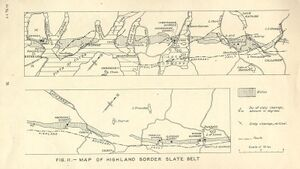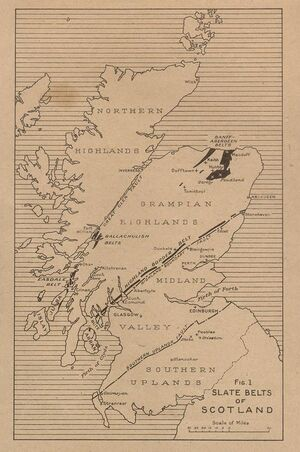Highland Border slate belt, Scotland
| From: Richey, J.E. and Anderson, J.G.C. 1944. Scottish slates. Wartime pamphlet No. 40. London : Geological Survey of Great Britain. |
Distribution and geological features


It has already been pointed out that the south-east margin of the Scottish Highlands is marked by a major fracture, termed the Highland Boundary Fault, which follows a south-westerly course from Stonehaven to Arran. Running roughly parallel and north-west of this fault, at a distance of from 1 to 4 miles, is an almost continuous belt of slate-rock which can be traced from the North Sea to the Firth of Clyde. The existence of this belt will doubtless be well known to many readers who have noticed the quarries which have been opened in it at almost every locality where a road crosses the Highland Border. In fact, to the passer-by with even a slight knowledge of geology, these quarries are an indication that a different natural region has been entered, as the hard, comparatively, dark slates, with steeply inclined cleavage, are a striking contrast to the red sandstones which he has left only a short distance to the south-east.
The slates near the Highland Border have been given a variety of names from the different localities where they have been worked, e.g. Dunoon Phyillites, Luss Slates, Aberfoyle Slates, Dunkeld Slates. The geologist, however, prefers to apply a general name to rocks belonging to the same formation wherever they occur. The general name chosen in this case is the Aberfoyle Slates, which will be used in the sequel.
In colour the Aberfoyle Slates include blue, grey, green and purple varieties. They are thus lighter in colour than the dark-grey slates of Ballachulish and the Western Highlans (Easdale, etc.), from which, moreover, they differ in the almost complete absence of pyrites crystals (‘diamonds’). As a broad generalisation it may be stated that the slates from the Highland border region are slightly thicker and with slightly less regular surfaces than those from Ballachullish and the West Highlands, though it does not necessarily follow that the slates from a particular quarry along the Highland Border are invariably heavier than those from a particular quarry in the other areas. The cleavage of the Aberfoyle Slates usually lies at a fairly steep angle. It dips to the south-east, south-west of Loch Lomond, north-east of which it passes through the vertical and then from Aberfoyle to the North Sea almost invariably dips to the north-east.
Included within the total width of outcrop of the Aberfoyle Slates there are subordinate bands of other types of rock such as schistose grits. Thin beds of limestone are also associated with the slate-rock, notably in the Clyde area. Further, as in most slate areas, only a proportion of the total bulk of slate-rock consists of slate in the commercial sense of the word.
The Aberfoyle Slates are flanked to the north-west and south-east by schistose grits. There is evidence that the two belts of grits belong to the same geological formation and form the limbs of an anticline in the core of which the slates lie. It is possible in fact that the slates owe their perfect cleavage to their position in the centre of this fold, during the formation of which they would be subjected to very great pressure. Immediately north-west of the slates in the Dunoon area (P519823) greenish grits occur, rich in dark green chlorite and bright green epidote and belonging to a formation termed the ‘Green Beds’.
For the purposes of general description the slate belts, may be dealt with three portions as follows:- (a) The South-Western or Firth of Clyde Area: from Arran to the west side of Loch Lomond. (b) The Central or Perthshire Area: from the east side of Loch Lomond to near Blairgowrie: (c) The Northern-Eastern or Angus and Kincardine Area: from near Blairgowrie to the North Sea.
South-western area
The Aberfoyle Slates occur in Arran (P519813) , where they have been quarried east of Loch Ranza (details). They do not outcrop on the north shores of the island, where they are hidden by a downfaulted strip of younger rocks.
The slates are next seen in Bute, where they form an outcrop stretching across the island north of Port Bannatyne (P519823) . They have been worked at one or two localities (details). They reappear on the east side of Loch Striven, opposite Bute, and continue on a north-easterly course to Dunoon. Near the last-named town they were formerly quarried on a small scale, but as the workings are not of importance they are not described in detail here [1]. Slate was also worked at one time west of Innellan in a band which does not belong to the main belt of the Aberfoyle Slates but is intercalated with grits lying to the south-east [1].
Between Loch Long and the Gare Loch the grits form an outcrop stretching from Cove to Rosneath. This outcrop is not in line with that of Dunoon but is offset to the north for over a mile by a fault. There are a few small unimportant openings in the slates in this area.
From the east side of the Gare Loch the slates continue across Glen Fruin to Loch Lomond, at Luss. In several instances the outcrop is shifted a short distance to the north on the east side of north-north-easterly faults. In the neighbourhood of Luss the Slates have been worked for 500 years. The quarries, one of which is in production, area described below (see under IV 3).
Central area
(P519823) On the east side of Loch Lomond, the slates form an outcrop S. of Rowardennan. This outcrop is not in alignment with that of Luss, an effect on intervening faults. Similar faults, all of which shift the slates to the north on their east side, complicate the wide outcrop of slates which has been traced from Loch Lomond to Aberfoyle. Near the last-named locality are situated the most important quarries of the Highland Border slate belt. The workings, records of which date back for at least 250 years, are described in detail below (for details see below under IV 4).
Not far to the north-east of the Aberfoyle Quarries there is a series of north-north-easterly faults, the cumulative effect of which is to shift the slate outcrop northwards to the south side of Loch Lubnaig. There are small workings on the hillside east of the loch. From this locality the Aberfoyle Slates follow an uninterrupted course to Comrie, west of which they have been worked in the Aberuchil Quarry (for details see below under IV 5).
To north-east of Comrie the outcrop of the slates is broken between Glen Turret and Glen Almond by overlying rocks of Lower Old Red Sandstone age, which here occupy a considerable area north-west of the Highland Boundary Fault. To north-east of Glen Almond is a large quarry near Logiealmond, which was worked up to about the beginning of the 1914-1918 War (for details see below under IV 6). Several other small openings occur to the north-east, the most important of which is in Glen Shee.
The slate outcrop crosses the Tay Valley south of Dunkeld, and there are quarries of considerable size on both sides of the river (for details see below under IV 7).
To north-east of Dunkeld the slates form an uninterrupted outcrop as far as Bridge of Cally, 5 ml. north-north-west of Blairgowrie (P519813) . There are old quarries at Milton of Rochallie, one mile east-south-east of Bridge of Cally, but, as there are of small size and as the rock is much obscured by debris, it is doubtful if they are of any economic interest.
North-eastern area
(P519813) In this area the slates do not form so continuous an outcrop as in the case to the south-west. They are, moreover, much less frequently exposed owing to the presence of heavy overburden. In such small quarries as occur they appear to be of poorer quality than to the south-west. This may be due both to the higher degree of alteration of the rocks near the Highland Boundary Fault in the north-eastern area and to the greater proximity of the slates either to the Highland Boundary Fault itself, or to faults a short distance to the north-west which run parallel to it. For these reasons the north-eastern area is not described in detail, though a few small quarries are briefly mentioned below.
North-east of Blairgowrie the slates are not seen for about 12 miles, being hidden under an outcrop of Lower Old Red Sandstone rocks which lies north-west of the Highland Boundary Fault. The slates reappear in Glen Prosen and Glen Glova between Blairgowrie and Edzell but are not well exposed. Further to the north-east, in the valley of the Cruick Water 8 miles west by Edzell, the slates have been wrought in a number of small openings but do not appear to be of good quality. There is another small quarry beside the west bank of the West Water, half a mile north-west of Bridgend, which lies 4 miles west of Edzell. The slates are also exposed in Glen Esk, above Edzell, but are rather crushed.
Between Glen Esk and the North Sea the slates are involved with the grits in complicated folding and appear only in discontinuous outcrops, none of which appears to be of value from the quarrying point of view.